|
|
 |
Fiche d'espèce de Copépode |
|
|
Cyclopoida ( Ordre ) |
|
|
|
Oncaeidae ( Famille ) |
|
|
|
Oncaea ( Genre ) |
|
|
| |
Oncaea grossa Heron & Frost, 2000 (F,M) | |
| | | | | | | Ref.: | | | Heron & Frost, 2000 (p.1042, figs.F,M, tab.2, 3) | 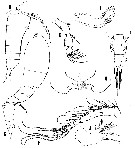 issued from : G.A. Heron & B.W. Frost in Proc. Biol. Soc. Washington, 2000, 113 (4). [p.1043, Fig.15, C-J]. Female (from NE Pacific): C, habitus (lateral; scale bar: t); D, pediger 4 posterior corner and urosome (dorsal; scale bar: t); E, right A1 (scale bar: x); G, right A2 (scale bar: x); H, labrum (scale bary); I, left Md (scale bar: y); J, right Mx1 (scale bar y). Scale bars: 0.1 mm, see figures 3, 4, 5, 10 of Heron and Frost, 2000 for Oncaea canadensis and Oncaea insolita. Nota: Ratio of length of prosome to that of urosome 2.16:1. Genital segment length approximately equal to that of remainder of urosome, anteroventral surface with transverse rows of minute spinules on and around a protruding ledge, followed by horizontal rows of small spinules. P5 with elongate free segment, 2 terminal setae, the longer less than twice the length of the shorter, which is dentiform; outer basal seta. P6 represented by spiniform setule on gonopore.
|
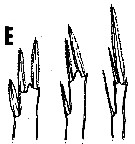 issued from : G.A. Heron & B.W. Frost in Proc. Biol. Soc. Washington, 2000, 113 (4). [p.1022, Fig.2, E]. Female: P2-P4 endopod terminal ''spine set'' (combination of the lengths, shapes, and position of the three or two terminal spines on the endopods of swimming legs 2-4 , from left to right in figure, for different Oncaea' species). Nota: endopod of P2 with lateral spine extending beyond distal margin cone.
|
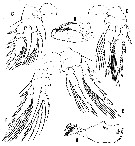 issued from : G.A. Heron & B.W. Frost in Proc. Biol. Soc. Washington, 2000, 113 (4). [p.1044, Fig.16]. Female: A, right Mx2 (scale bar: v); B, right Mxp (scale bar: x); C-F, P1 to P4 (scale bar: x). Scale bars: 0.1 mm, see figures 3, 4, 5, 10 of Heron and Frost, 2000 for Oncaea canadensis and Oncaea insolita. Nota: Endopods of P2 and P3 with a small terminal cone, P4 without.
|
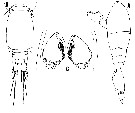 issued from : G.A. Heron & B.W. Frost in Proc. Biol. Soc. Washington, 2000, 113 (4). [p.1045, Fig.17, A-C]. Male: A, habitus (lateral; scale bar: t); B, pediger 4 posterior corner and urosome (dorsal; scale bar: x); C, Mxp (ventral; scale bar: x). Scale bars: 0.1 mm, see figures 3, 4, 5, 10 of Heron and Frost, 2000 for Oncaea canadensis and Oncaea insolita. Nota: Ratio of length of prosome to that of urosome 1.97:1. Swimming legs as in female. P5 not delimited from thoracic segment, armament similar to that of female. P6 represented by posterolateral flap on ventral surface of genital segment.
| | | | | Ref. compl.: | | | Nishibe & Ikeda, 2007 (p.609, vertical distribution, seasonal variations); 2008 (p.398, tab.1) | | | | NZ: | 2 | | |
|
Carte de distribution de Oncaea grossa par zones géographiques
|
| | | 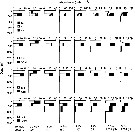 issued from : Y. Nishibe & T. Ikeda in Mar. Biol., 2007, 150. [p.618, Fig.9]; issued from : Y. Nishibe & T. Ikeda in Mar. Biol., 2007, 150. [p.618, Fig.9];
Oncaea grossa. Vertical distribution of each developmental stage (C1-C6) at site H (41°30'N, 145°47'E, depth 6,670 m, in the Oyashio region).
Female and male data are shown separately for C4-C6.
Abbreviations are D day, N night. |
 issued from : Y. Nishibe & T. Ikeda in Mar. Biol., 2007, 150. [p.612, Fig.2]; issued from : Y. Nishibe & T. Ikeda in Mar. Biol., 2007, 150. [p.612, Fig.2];
Vertical profiles of temperature (solid line) and salinity (broken line) at site H (41°30'N, 145°47'E, depth 6,670 m, in the Oyashio region). |
| | | | Loc: | | | NE Japan (Oyashio region), Alaska (Prince William Sound), Station 'P', Washington inland | | | | N: | 4 | | | | Lg.: | | | (848) F: 0,76-0,81; M: 0,63-0,7; { F: 0,76-0,81; M: 0,63-0,70} | | | | Rem.: | mesopelagic.
For Heron & Frost (2000, p.1045) the species closely resembles O. prolata in many characters. The denticles of the P5 female are conspicuaous and obscure for O. prolata. The Mxp male has a robust 2nd segment with rows of conspicuous spatulate setules, while O. prolata | | | Dernière mise à jour : 26/01/2015 | |
|
|
 Toute utilisation de ce site pour une publication sera mentionnée avec la référence suivante : Toute utilisation de ce site pour une publication sera mentionnée avec la référence suivante :
Razouls C., Desreumaux N., Kouwenberg J. et de Bovée F., 2005-2025. - Biodiversité des Copépodes planctoniques marins (morphologie, répartition géographique et données biologiques). Sorbonne Université, CNRS. Disponible sur http://copepodes.obs-banyuls.fr [Accédé le 21 octobre 2025] © copyright 2005-2025 Sorbonne Université, CNRS
|
|
 |
 |








